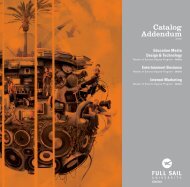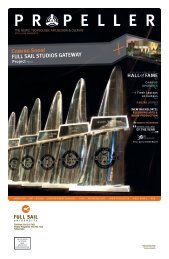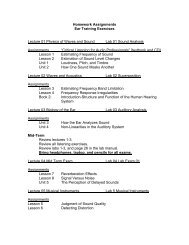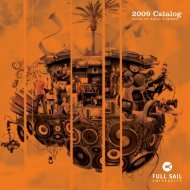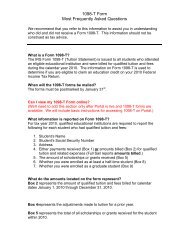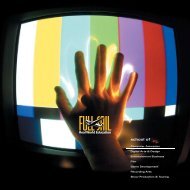Catalog Addendum - Full Sail University
Catalog Addendum - Full Sail University
Catalog Addendum - Full Sail University
- No tags were found...
Create successful ePaper yourself
Turn your PDF publications into a flip-book with our unique Google optimized e-Paper software.
Course DescriptionsGDN 4340Aesthetics and ImmersionGDN 3140Design ProjectGDN 3430Design Tools IGDN 1440EconomicsThe Aesthetics and Immersion Courseexamines the latest research in immersion,addiction, and basic learning theories as theyapply to game design. These techniques area growing discipline within the game designworld as they can influence sales and gameenjoyment through paradigms such as theaesthetic usability effect. This course outlinesthe constructs of aesthetics and immersionas separate yet intertwined disciplines. In thiscourse, the psychology of aesthetic design istraced back to its historic roots while also givingthe student a current understanding of the field.Course OutlineHistorical Aesthetics—Changing TimesCurrent AestheticsAesthetic TendenciesCurrent Immersion TechniquesImmersion ResearchBasic Learning TheoryReward Systems and AddictionTotal credit hours 4.0Course length4 WeeksGDN 2130Design andDevelopment AnalysisThe Design and Development AnalysisCourse teaches the student techniques usedto deconstruct, reproduce, and improve existinggames based on a thorough analytical process.The ability to critically analyze other’s work isessential to the design phase of any project, andthe video game industry is no exception to this.By playing and deconstructing games, studentswill learn the complicated design systemsrunning behind the scenes in games and willcompose documents to support their findings.Course OutlineThe Design Project Course builds on thedocumentation skills gained in Game Design Iand the critical and analytical techniques testedin courses such as Statistics, Economics, andUsability. This course challenges studentsto apply what they know. In teams, studentsgenerate ideas, design playable componentsaround those ideas, and document theirdecisions through a collaborative and analyticalprocess. Focus is placed on the mechanics,flow, and fun factor. The goal of the project isfor students to appreciate the complexity ofcollaborative game design, to fine-tune theapplication of their technical design skills, and toensure their design is well-suited to an intendedmarket and meets all milestones.Course OutlineDesign Document ReviewGame Feature BreakdownsRefactoring DesignsDesign Mechanic ReviewDesign Reviews & FeedbackIndependent WorkTotal credit hours 4.0Course length4 WeeksIn the Design Tools I Course, studentsexamine the various development tools used tocreate games. Students explore game engines,asset libraries, graphic art tools, and levelediting tools. The intention of the course is not tofine-tune the use of all the game creation toolsdiscussed; it is to provide a working knowledgeof the tools so that designers can bring theirdesigns to life as well as create a single level inan actual game engine.Course OutlineIntro to Design ToolsGame EnginesModeling & Design PackagesTexturesLevel ReviewWikisTotal credit hours 3.0Course length4 WeeksGDN 3540Design Tools IIIn the Design Tools II Course, studentstake a much closer look at the tools employedin the creation of game levels. Specifically,students are instructed in the use of stateof-the-artlevel editors employed by the gameindustry. Level editors are some of the mostimportant tools a designer will encounter inthe industry. Depending on the robustnessof the editor, a designer can create entireenvironments—complete with audio andvisual content, AI entities, and complex gameobjectives—from within the one tool. Bylearning these editors, students are betterprepared to apply the concepts they will learnin future level design courses.The Economics Course examines howpeople make choices and use resources.This course focuses specifically on gameeconomics and will examine how marketsare created and maintained in game worlds.Students will learn how players allocatetheir resources in a limited market, whiletrying to satisfy their wants and needs. Thisis maintained through economic balanceand fluctuations that are controlled by thedesigner and must be maintained throughoutthe development process. Topics of studyinclude basic economic theory, inflation,supply & demand, poverty & inequality, andmarket stability.Course OutlineReal World vs. Game EconomicsSupply & DemandMarket EquilibriumMarket Creation & MaintenanceMMO EconomiesPlayer MotivesInequality and BalanceTotal credit hours 4.0Course length4 WeeksGame Analysis TechniquesCourse OutlineGame Mechanics AnalysisReward Systems AnalysisInterface/Input AnalysisAdvanced Game Systems (Combat, etc.)Document RecreationGame EnginesLevel EditorsGeometry (Static, Dynamic, Terrain)Textures and MaterialsLightingTotal credit hours 3.0Course length4 WeeksAI/ScriptingTotal credit hours 4.0Course length4 WeeksGAME DE SIGN | Bachelor o f Science Degree Program7



